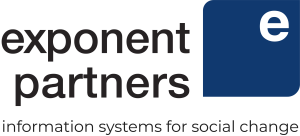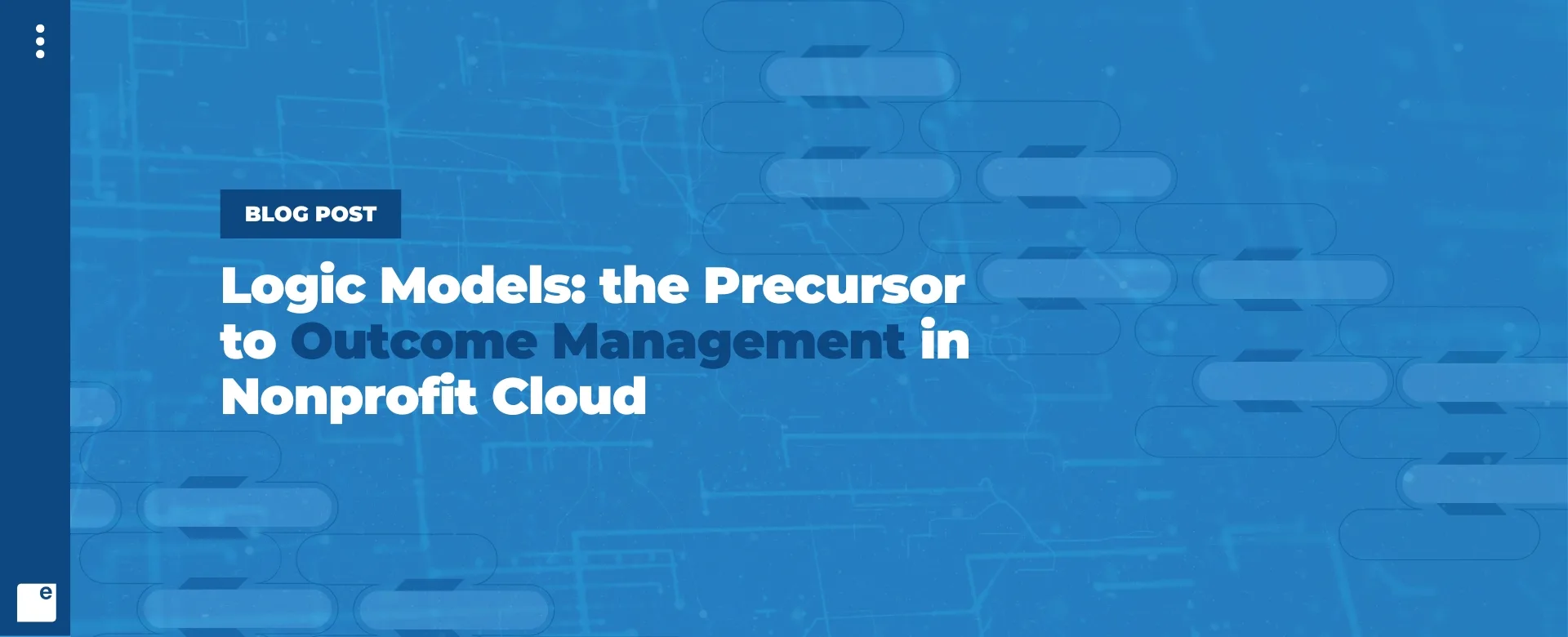Logic Models: the Precursor to Outcome Management in Nonprofit Cloud
While data collection has long been essential, the ability to decode data into meaningful outcomes can truly drive nonprofits, and their missions, forward. Last year, a new era of impact measurement emerged with Salesforce’s Winter ’24 release of Nonprofit Cloud that included Outcome Management. This groundbreaking new functionality empowers organizations to define, measure, and evaluate program outcomes with unparalleled precision, all within a unified platform.
But here’s the crucial piece: you can’t properly define, measure, and start tracking outcomes without a logic model. Logic models serve as the backbone of outcome measurement, offering a structured framework to connect inputs, strategies, outputs, and outcomes. They provide clarity amidst complexity, guiding organizations toward their mission-driven goals.
At Exponent Partners, we’ve been pioneers in outcomes expertise for over two decades. While Outcome Management may be a new concept for Salesforce, it’s a terrain we’ve navigated extensively. Over the past 20 years, we’ve developed our own suite of tools to equip human services agencies with the means to gain a deep understanding of their true outcomes. Now, as Salesforce enhances its offerings with Nonprofit Cloud’s Outcome Management functionality, we see this investment and commitment as a pivotal step towards enabling nonprofits to reach new heights. We’re thrilled to share our expertise and assist more organizations in harnessing the power of the latest innovative technology from Salesforce. In this blog, we’ll delve into the precursor for leveraging Outcome Management effectively: logic models.
A Brief Overview of Outcome Management and Logic Models
Traditionally, nonprofits have relied on basic output data to showcase their impact—a snapshot of participation numbers or services rendered. But what if we dared to go beyond mere reporting? What if we could delve into the heart of our programs, dissecting the nuanced outcomes that truly drive change? What if we could clearly answer: do our actions truly result in the intended outcomes? This is where Outcome Management shines brightest, offering a comprehensive framework for strategic decision-making and investment.
Outcome Management in Nonprofit Cloud allows organizations to:
- Collect information from participants before, during, and after program activities
- Define and group outcomes
- Connect outcomes to programs and benefits
- Establish a consistent library of indicators your organization cares about for easy reuse
- Use time-bound indicator performance periods to track your starting point and where you aim to get to when measuring your efforts
But before you ever get to that, you need a logic model. Logic models serve as the backbone of outcome measurement, illuminating the intricate pathways between program activities and desired outcomes. They provide clarity amid complexity, offering a roadmap for organizational success. But crafting a robust logic model requires expertise and finesse—a task we excel at.
Understanding the Foundation: Logic Models
Logic models are not just diagrams; they are the blueprints of social change. They intricately weave together your organization’s purpose, strategies, activities, outputs, outcomes, and impact into a cohesive narrative. Imagine you’re planning a road trip from one city to another. Before embarking on your journey, you wouldn’t just hop in the car and start driving aimlessly. You’d likely use a map or GPS to chart your course, right? Well, think of a logic model as your roadmap for your nonprofit’s journey towards its mission-driven goals.
Logic models serve as a way to express organizational and programmatic values and mission. They offer a map that connects investments and activities with outcomes. Logic models are a guide for measuring program outcomes and implementation. Finally, they provide a common shared vocabulary and framework for discussions and decisions.
The Anatomy of a Logic Model
The components of a logic model include:
- Inputs/Resources: These are the building blocks of your programs, encompassing everything you need to do the work from budgets to staff and facilities.
- Strategies & Activities: The actions you take to bring about change. This is the intervention that you are using and can be as concrete as conducting workshops or as intangible as providing counseling.
- Outputs & Outcomes: Outputs are the immediate results of your efforts, while outcomes are the long-term changes you aim to achieve.
- Impact: The ultimate goal, representing the profound difference your organization makes in the world.
Going back to the road trip example, the inputs are akin to the fuel, snacks, and supplies you pack for the trip. These are the resources you need to execute your plan. The strategies and activities are like the specific routes you choose to take and the stops you make along the way—each strategically selected to help you reach your destination.
Now, let’s talk about outputs and outcomes. Outputs are the measurable checkpoints along your journey—like the number of miles traveled or the landmarks you pass. They indicate progress but don’t necessarily tell you if you’re getting closer to your final destination. Outcomes, on the other hand, are like reaching your intended destination—the real impact you’re striving to achieve. It’s arriving at your destination safely, experiencing new sights, and making lasting memories.
Developing Your Logic Model
Once you’ve assembled all the components of your logic model, it’s time to understand the intricate “if-then” relationships that connect them. These relationships serve as the backbone of your logic model, guiding your program from inputs to outcomes: if resources are available to the program, then program activities can be implemented; if program activities are implemented successfully, then certain outputs and outcomes can be expected.
However, it’s essential to acknowledge a common pitfall: the tendency to focus solely on tracking outputs. Outputs, such as the number of workshops held or attendees, are often more straightforward to measure and may already be tracked for reporting purposes. While outputs are important indicators of program performance, they only represent part of the equation.
Logic models compel us to ask the critical question: “So what?” Merely tracking outputs doesn’t guarantee desired outcomes. For instance, knowing that someone attended a workshop provides limited insight into the program’s impact. Instead, focusing on the intended outcome—such as increased confidence in job applications resulting from workshop attendance—offers more meaningful evidence of program effectiveness.
Therefore, while it’s crucial to track outputs as a measure of program activity, they should be viewed as stepping stones toward achieving desired outcomes. Here are some tips for building a robust logic model:
- Work Backwards: Start with your desired outcomes and work backward to identify the activities and inputs necessary to achieve them. This approach ensures that every program component is aligned with your overarching goals.
- Focus on Change: Logic models should emphasize the transformative change your program seeks to achieve. By clearly defining the changes you aim to make, you can design activities and outputs that directly contribute to these outcomes.
- Develop Key Program Pathways: Identify the primary pathways through which your program influences outcomes. By understanding these pathways, you can prioritize activities and allocate resources more effectively.
- Consider Connections: Explore the interconnections between different aspects of your program, such as inputs, activities, outputs, and outcomes. Recognize that multiple pathways may exist, each contributing to different outcomes.
- Partner with Experts: Collaborate with experienced partners who understand logic models, potential pitfalls, and outcomes measurement in detail. Their expertise can help you develop a robust logic model that accurately reflects your program’s theory of change and goals.
Technology as Your Ally
Once you’ve taken the time to develop your own logic model, the best thing you can do is to create a “living logic model,” accessible to all, constantly evolving with real-time data insights. Technology can be the catalyst for transforming static diagrams into dynamic tools for learning and growth. We recommend codifying it and integrating your logic model right alongside the rest of your systems. Why? Because over time, what we say we do, what we actually do, and what we measure can start to diverge. All the more reason to integrate it with the technology you are using to track your work.
Conclusion
Logic models are not just theoretical constructs; they are the manifestation of your organization’s commitment to change. Embrace them not as rigid frameworks but as dynamic narratives of impact. Here at Exponent Partners, we can help your team develop its own logic model and outcomes measurement framework, and we can even help you implement it into Nonprofit Cloud or whichever Salesforce technology you use for your programmatic efforts. Together, let’s unleash the full potential of your nonprofit’s mission and drive radically better outcomes. Schedule your free consultation today!


